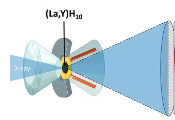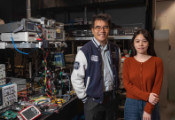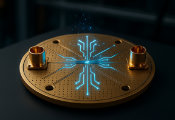Squeezed Light for Photonic Quantum Computing
NTT Research in California is developing a new type of photonic quantum computer that could be faster and used less power. The Coherent Ising Machine (CIM) being developed by NTT Research is a hybrid classical and quantum machine based on photonic circuits. It uses a network of optical parametric oscillators (OPOs) programmed to solve problems that have been mapped to an Ising model, a mathematical abstraction of magnetic systems composed of competitively interacting spins or angular momentums of fundamental particles.
While many companies are taking a gate-based approach to quantum computing, the CIM relies on physics-based processing. Rather than using local coherence through entangled qubits, it uses natural global coherence. This needs new optical technologies such as nanometre manufacturing of Thin-Film Lithium Niobate (TFLN) devices
An OPO is a coherent light source, similar to a laser, based on parametric amplification within an optical resonator. With an Ising model, optimization problems can be mapped to OPOs, which find the lowest-energy configuration of spins that will yield a solution to the problem at hand. The optimization is a bifurcation process guided by both the OPO nonlinearity and the optical coupling between OPOs.
The CIM starts in one state that’s a mix of all the desired states. Beginning in a vacuum state with OPOs below threshold, the CIM gradually increases the pump power until the OPOs are above the threshold. From here, the vacuum state settles into a local minimum and produces the solution. Due to its optical nature, the CIM is not subject to thermal noise.
The use of optics and lasers in the CIM give it a big advantage over classical computing in terms of bandwidth – about 200THz, vs. a few GHz for classical – which leads to faster communications and computations. Optical circuits can also perform simultaneous computations while minimizing energy consumption.
Quantum gated computing uses commercially available hardware to perform calculations. Although it can be successfully implemented, the system has significant limitations with scalability when compared to the CIM. When running algorithms on superconducting hardware, to ensure reliable, low-noise qubit operation the hardware must be reduced to a temperature of about 5 millikelvin (mK). This is challenging because it requires dilution refrigerators and the chips are highly sensitive to even small amounts of heating, making scaling to many qubits difficult.
Quantum gate computing with error correction can theoretically be exponentially faster than a classical computer at solving certain problems like factoring, simulating complex molecules, or complex quantum dynamics. But there are few known cases at present where a quantum computer is known to run much faster than a standard laptop.
Quantum annealing and the CIM are both spin systems that contain qubits in superpositions, allowing for an optimization function to be encoded. But the systems tackle this using different approaches.
With quantum annealing, if there is no noise within the system and the anneal is performed sufficiently slowly, it stays in the ground state. But for many problems, the required anneal time is exponentially long, making it an impractical solution.
Digital annealers are a type of classical computer that solve combinatorial optimization problems at high speed with digital circuits inspired by quantum phenomena. Their design solves one specific problem with one algorithm, typically an Ising problem. While digital annealers can be much faster than CPUs/GPUs because their circuitry is optimized, they are still bottlenecked by digital CMOS hardware constraints. So, other platforms that aren’t subject to those constraints, including quantum annealers and CIMs, may still outperform digital annealers.
The CIM may also prove to be a beneficial tool for artificial intelligence applications such as machine learning. Research is currently underway at MIT on applying CIM-like hardware to accelerate deep neural networks. These experimental implementations of the CIM take advantage of fiber-optic time multiplexing, which enables optical data to be multiplexed both in time and space on different wavelengths. This enables hardware to make maximum use of energy, producing high overall compute performance with great efficiency.
Work is underway on creating higher levels of squeezed light and on creating more flexible and adaptable CIM hardware, especially to different kinds of connectivity between spins. Today, connectivity is largely limited to nearest neighbour spins. Integrating field programmable gate arrays (FPGAs) is one potential solution because of their intrinsic parallelism and flexible architecture.
Some researchers predict a commercially available CIM by the early 2030s. If true, the computer would likely appear similar to LASOLV, a computing machine developed by NTT based on photonics technologies. LASOLV is currently operating under the consulting of NTT Computer and Data Science Laboratories.




































